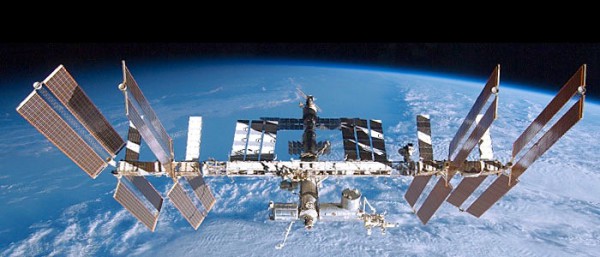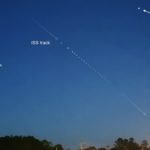I was recently asked by a local magazine The Kitchen Draw to write an article about science and/or space. I wrote two articles and the space one won out. It’s about how to spot the International Space Station. I couldn’t find it on the site as it was print only but I figured I’d post what I wrote here because why not eh? So, without further ado.
Did you know that you can see the International Space Station with the unaided eye? In fact you might have seen it and not even realized it. Let’s start off with what we’re looking at in the first place.
What is the International Space Station?
The ISS is the largest man made structure ever built in space. If you were to lay it on a football field it would extend beyond the boundary lines. It measures some 350ft long and weighs in at over 100 tons. There are currently 6 crew on board but when shuttle was flying, there were as many as 13 on board. Construction on the station was completed in 2011 as the space shuttle went into retirement and it took 12 years to complete.
The purpose of the space station is multifaceted in that we want to know how to build things in space, live in space and conduct science in space. The effects of micro-gravity on the human body aren’t entirely understood and zero-g experiments on Earth are nearly impossible to conduct.

Ok, so, where is it?
It’s in space! OK, more specifically it’s in low earth orbit at an altitude of around 350km (220mi). The average speed of station is around 28000kmh (17,500mph). If that sounds fast, that’s because it is fast. Any slower and it would fall right back to Earth!
The first thing you need to know is when to look. Here’s a site I use which allows you to set up email notifications: spotthestation.nasa.gov.
The trick with looking for the ISS is that you can only see it with the naked eye in the morning or in the evening. The reason is that during the height of the day it’s just too bright to see the station. In the middle of the night the station will be in Earth’s shadow. Morning and evening is when you’re catching it in between these two extremes.
Now that you know when too look, you need to know where. Personally, I prefer evening viewing as I’m just not a morning person. The site will give you the option for either or both times of day. When you get a notification it might look confusing but it’s really quite easy once you get the hang of it. The diagram on this page will help to get you oriented but at the very least so long as you which direction to look (i.e. Northwest at 6:52pm) then you’re in pretty good shape.

So what are you looking for anyway?
It will initially appear as a slow moving dot and might even look like a plane. This is why you might have seen it and not realized what it was. The thing is, you won’t hear any sound and you won’t see any blinking lights.
What’s in it for me?
As much as I’d like to say it’ll be this massive object with solar panels bulging out and astronauts hanging off of it; it isn’t.
Wait, there is more! Despite it not appearing as more than a bright, fast moving dot, you have to remind yourself there are people inside that dot. They’re passing nearly directly over your head at many times the speed of a bullet. They’re studying everything from material science to medicine to planetary science.
To me that’s awesome enough but there’s one more thing station will do if viewed in the evening; it will pass into Earth’s shadow. It’s quite a sight to see as the white dot slowly takes on a yellow tint, then orange, and finally a deep red before being eclipsed by our home planet.
The take away, for me, is a deeper understanding of our place in the Universe. The ISS is a sort of beacon of humanity and what we can accomplish when we work together. As it is now, the International Space Station is our single outpost in space and will be for some time. Why not take a few minutes of a warm summer evening and gaze upward? It’s a subtle event but it’s worth your time. I’ll never forget the first time I said “Wow… There it is!”
Keep this in mind; This is what you’re seeing
Please watch this video. Set screen to full. Set to the highest resolution your internet can handle and turn it up. You won’t regret it.